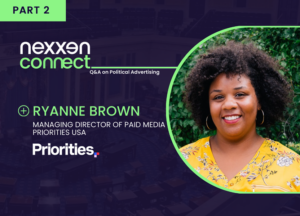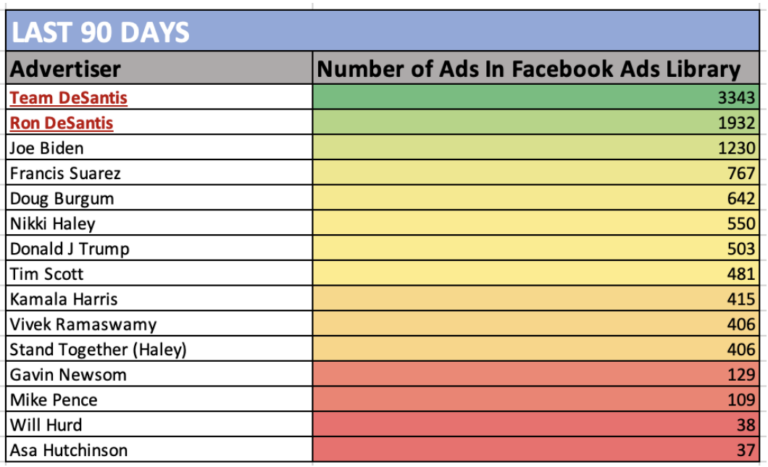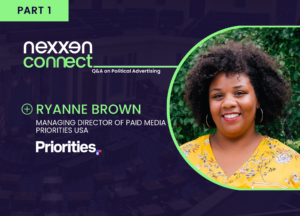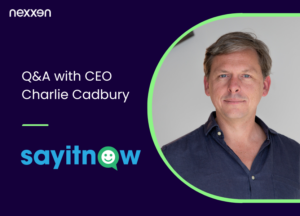

Nexxen Connect: Q&A on Political Advertising with Andrew Mullins
This edition spotlights Andrew Mullins, VP of Advertising & Data Ops, IMGE.
Andrew is a campaign digital advertising veteran and true ad tech nerd. An alum of the Republican Governors Association, Trump 2020, and Direct Persuasion, he recently served as Digital Ads Director for Ron DeSantis for President. Currently, he works across DC firms IMGE and AdVictory on all things measurement and digital ads.
You are fresh off a competitive presidential campaign – can you share a favorite highlight/memory of yours during the primary season?

Andrew Mullins
VP of Advertising & Data Ops, IMGE
The debates, by far. They’re a crazy, unscripted experience where you have the best and brightest of your party try to differentiate themselves. Watching the debates was harrowing, and really fun. Some of our best work came from rapid-response hits during the GOP debates, especially the Newsom-DeSantis debate in November 2023.
Campaigns often operate like a start-up, how did you approach building a team to execute against your strategy?
Everything is bootstrapped like you wouldn’t believe. You don’t have the luxury of a huge team of staff or a big operational budget. Presidential campaigns, especially, usually only have a matter of weeks or days to ramp up and launch. This forces you to wear a lot of hats. Imagine something akin to assembling an airplane while it’s taking off.
During this cycle, there were times where I was the account manager, graphic designer (literally), merch designer, data analyst, media strategist, video producer, web designer, and copywriter all at once. Obviously we had a great team supporting us, but you have to be ready to wear A LOT of hats on a presidential campaign.
How has this cycle been different from an online fundraising standpoint compared to previous cycles?
This is the third presidential cycle I have been involved in on the digital side of things. This cycle was weird, because it never felt like the GOP had an actual primary. News events (particularly indictments) completely dominated the cycle, and visibly shifted the direction that fundraising dollars flowed.
My immediate team lived in Google Search trends, and at one point this cycle it became obvious that only God and Taylor Swift could compete against Donald Trump in online search interest.

Andrew Mullins
VP of Advertising & Data Ops, IMGE
This edition spotlights Andrew Mullins, VP of Advertising & Data Ops, IMGE.
Andrew is a campaign digital advertising veteran and true ad tech nerd. An alum of the Republican Governors Association, Trump 2020, and Direct Persuasion, he recently served as Digital Ads Director for Ron DeSantis for President. Currently, he works across DC firms IMGE and AdVictory on all things measurement and digital ads.
You are fresh off a competitive presidential campaign – can you share a favorite highlight/memory of yours during the primary season?
The debates, by far. They’re a crazy, unscripted experience where you have the best and brightest of your party try to differentiate themselves. Watching the debates was harrowing, and really fun. Some of our best work came from rapid-response hits during the GOP debates, especially the Newsom-DeSantis debate in November 2023.
Campaigns often operate like a start-up, how did you approach building a team to execute against your strategy?
Everything is bootstrapped like you wouldn’t believe. You don’t have the luxury of a huge team of staff or a big operational budget. Presidential campaigns, especially, usually only have a matter of weeks or days to ramp up and launch. This forces you to wear a lot of hats. Imagine something akin to assembling an airplane while it’s taking off.
During this cycle, there were times where I was the account manager, graphic designer (literally), merch designer, data analyst, media strategist, video producer, web designer, and copywriter all at once. Obviously we had a great team supporting us, but you have to be ready to wear A LOT of hats on a presidential campaign.
How has this cycle been different from an online fundraising standpoint compared to previous cycles?
This is the third presidential cycle I have been involved in on the digital side of things. This cycle was weird, because it never felt like the GOP had an actual primary. News events (particularly indictments) completely dominated the cycle, and visibly shifted the direction that fundraising dollars flowed.
My immediate team lived in Google Search trends, and at one point this cycle it became obvious that only God and Taylor Swift could compete against Donald Trump in online search interest.
Lifetime value metrics gave us the insights we needed to focus on QUALITY user acquisition, not just high-quantity.
Lifetime value metrics gave us the insights we needed to focus on QUALITY user acquisition, not just high-quantity.
What are examples of how you tested new strategies with the direct response and paid media campaigns?
At the end of the day, voters (and donors) support a candidate because they want something from the candidate: Be it a policy position, or delivering a win for their Party.
For us, we wanted to offer our supporters something valuable and tangible in return for their donations or data. We never tried to trick or deceive our supporters (we never did those fake 1500% matches, for example). One way this manifested itself is in the way we handled debates.
For nearly every debate, we in-house executed a “trip to the debate” contest. Essentially, we’d offer our audience a chance to get flown out to a presidential debate in return for their email address, phone number, or a small donation. We executed everything we promised! When the contests would wrap up, our team woke up early on Saturdays to conduct an actual drawing (per the contest terms) and one of us would call the winner to share the happy news. This took on a gameshow “you just won a million dollars!!!!”-type vibe. Our audience loved these contests, and they really became a valuable way we expressed gratitude to our supporters.
As a follow up can you describe the process of creative iteration – why is it important, which parts are manual vs. automated?
We took a lot of pride in tracking every single data point of our paid marketing, and letting performance guide all of our decisions. For every user we acquired on ads, we knew exactly the tone, message, and targeting strategy that led to the user acquisition. This guided our entire creative process. For example – we learned pretty early on that border-centric ads brought in high-quality users that donated to our campaign weeks and months after acquisition. We weren’t so much looking at immediate metrics (like CPA or ROAS) as we were lifetime value metrics (like future donor conversion rate). Those metrics gave us the insights we needed to focus on QUALITY user acquisition, not just high-quantity. This is something most campaigns don’t have a data backbone to execute, and we did it well, and at scale.
We also tested literally everything. At one point in the cycle (like September I think), I tallied up the number of creatives we had been running on Facebook compared to other campaigns, and the results weren’t even close… (and this was just Facebook). We focused on iterative testing. We found components of an ad that drove performance (everything from message to font to background color), and iterated on the ad until we found the perfect mixture for performance.


With such focus on creative, did you make any efforts to optimize towards inventory or audience? Or does a results-driven ad campaign account for those naturally?
We focused a lot on audiences. I think by the end of the campaign, we had tested something like 600 unique audiences on our digital ads platforms. Inventory mattered, too. Although we keyed in pretty early on, on which ad placements drove the quality performance. It’s remarkable to me how few agencies and campaigns do a good job testing and measuring the value they’re providing in return for dollars.
What role, if any, did Connected TV play in rounding out your plans?
Connected TV was an awesome way to hit voters on a 1:1 basis. Closer to Iowa, it did a lot of lifting on saturating our modeled audiences… especially in DMAs that traditional TV struggles to hit because of state lines.
What about texting?
Texting was massive for us, and it shared the same approach and reporting structure that we used on ads. We took the same audience, and lifetime value metrics that we used on ads, to texting.
What’s next for you in your career, with the DeSantis campaign behind you?
In true campaign-cowboy form, I’m heading over to IMGE & AdVictory to work on ads. There was A LOT of really groundbreaking stuff we did on DeSantis that I want to use to help the Republican party win elections up and down the ballot. The best is yet to come!
What is your election night celebration tradition?
Always Chic-fil-a. At this point, it’s basically a superstition for me.
Would you do it again?
Absolutely. The learnings alone are something you could never buy with money. As someone that’s been on the committee, agency, and now candidate-side, I feel like this experience deepend my ability to execute and understand campaign pressures in a way that you don’t really get in other digital-political jobs.
Read Next
Connect With Us
Learn how you can effectively and meaningfully leverage today’s video and CTV opportunities with our end-to-end platform, data and insights.


